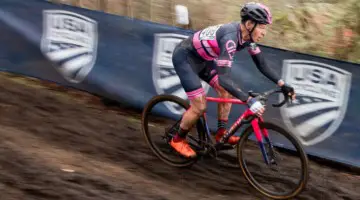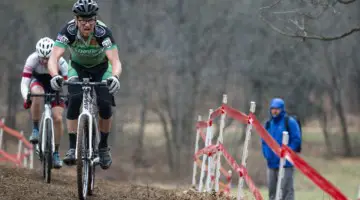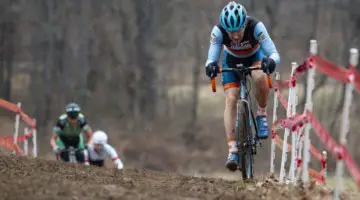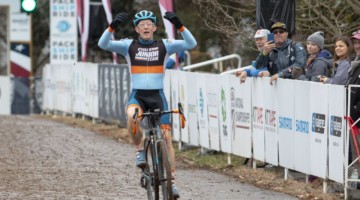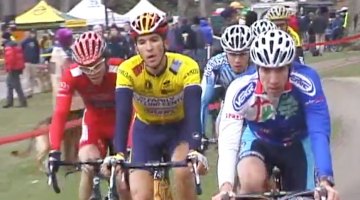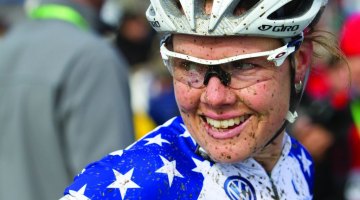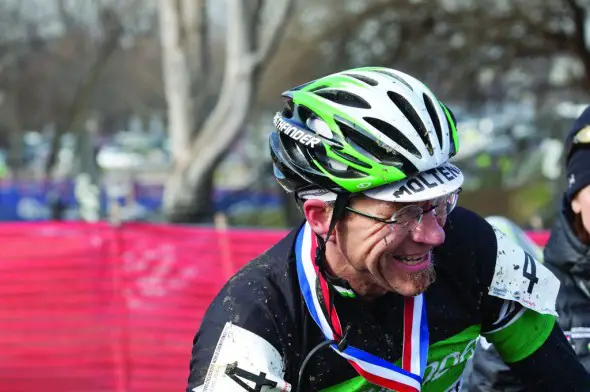
Gunnar Shogren was all smiles post-Worlds, even if the race didn’t go quite the way he wanted. © Brian Nelson
Gunnar Shogren, who took third this year at Masters Worlds in 50-54 Men, was our pick for our Quick and Dirty interview in Issue 21 of Cyclocross Magazine, but he had too much to say to fit it all on a two-page spread. So, here we have Shogren’s “Live and Uncut” interview for your reading pleasure. He’s got some great insight into the roots of US cyclocross, where racing is today, and why running tubeless might be the best choice a racer can make.
Cyclocross Magazine: You have as long a history as almost anyone among active Masters racers. When and how did you get started?
Gunner Shogren: While attending West Virginia University (WVU), I finally got my chance to race BMX, so in 1984 and ’85, that’s what I did. I also had a mountain bike then, but we were really just using it like a large BMX bike and breaking things. I cobbled a road bike together out of used parts at Pathfinder, an outdoors shop, where I was a mechanic.
In 1986, I did maybe two road races and several mountain bike races, all very small. In December of that year, I was finally done with college too. By 1987, I got a job as a research technician in the Animal and Veterinary Sciences department at WVU and got my USCF road license. Life had gotten good and was about to change forever.
During the course of that wondrous first year, I raced a lot and learned even more. I went from a Cat 4 to a 2 that season. About a third of the way through that year, I discovered Eddie B.’s “Bible” (Bicycle Road Racing: The Complete Program for Training and Competition by Edward Borysewicz) and, boy, did I study and digest that thing. Along with learning the importance of active rest and some tactics, I also learned about cyclocross. There was a little section devoted to it in there, mostly talking about off-season activities, but there’s also a picture. A picture of a really neat-looking road bike with tiny little knobbies going down a goat path.
That was it for me, I wanted to ride cyclocross. It wasn’t until the end of 1988 that I actually got a ’cross bike: a very whippy Vitus. I built up some 36-hole rough-and-tumble wheels for it, bought some Vittoria tires and off I went. I rode it all over the place during the off-season, took it on some mountain bike trails and tried to “figure it out” from the little amount of information that there was in some of the magazines and periodicals at the time. Really, there wasn’t much. Of course, I did what probably a lot of folks did (or still do) when they get their first ’cross bike. They’d decide that because the bike is so quick, they’ll probably be able to race a mountain bike trail and do pretty well if they’re careful enough on certain sections. Folks probably don’t think like that anymore because of the change in mountain bike technology, but, boy, did it run through our heads then.
I actually ended up doing a MTB stage race in 1989 on my cyclocross bike. It consisted of a hill climb, dual slalom and then a cross country race. The ‘cross bike crushed it on the hill climb, and though you wouldn’t have thought it, I was actually did fairly well in the dual slalom race. Then, in one of the final rounds I stacked it good, much to everyone’s pleasure. The cross country race went really well until I tried to go too fast on a rocky dirty road. I got a flat so I got my spare tubular out, put it on and got back in the game only to have the tire partially roll off a few more times. Then it was just a slow ride in for me. That’s the last time I’d try that.
I had a buddy that decided to race his cyclocross bike (same vintage) at what would now be considered an ultra mountain bike race. The original Canaan 50k. It was full of bogs and pretty much unrideable sections, so he decided that he would rather carry a light bike then try to ride and push a heavier one. I believe he endured a lot that day. He even won his class (45+) but never did that again.
As the early ‘90s rolled around, we had a band of merry riders from Morgantown, West Virginia, all trying out our own breed of cyclocross. A lot of us were on road bikes with knobby tires but a few of us had real cyclocross machines. The real limiting factor for all of us was the availability of decent cyclocross clinchers. We were doing a fair bit of dirt road riding and no one wanted to have to carry two tubulars. They were also too pricey for the poor bike shop rats that we were. Specialized came out with some tires, the Tricross, and even though the 28mm’s were closer to 25mm, they were pretty nice. Michelin also had a 28mm tire that was more true to size, but it came in some strange paddle wheel tread. Finally, somewhere in there, Ritchey came out with the SpeedMax in some decent 28mm and up sizes as well. What we could get is what we ran. I still even have some of those tires in my stock. We would create little courses, put up some barriers here and there and “train” but the real cyclocross races were still only in magazines and places far away.
Maybe around ’91, a few local mountain bike series’ tried to put on a cyclocross race or two, but they were mostly what we’d call “Jungle Cross” races. It was enough for us though, and so of course we’d show up. This was also a time when folks could just put some of the aforementioned 700x28mm tires on their road bike, change some gearing, swap out the pedals and go race. Most of the equipment was either not there or out of our price range, but we did the best we could.
In 1994, while racing for DBR, Keith Ketterer, a big advocate of cyclocross racing, decided that DBR was going to start doing cyclocross. So Dave Wiens, Susan DeMattei, Keith Ketterer and myself headed to Nationals in Seattle, Washington, the great Pacific Northwest, and I got my first taste of cyclocross culture. We arrived two days before Nats, but first we had to put our bikes together, get them fitted and only then, get out on the course! We had some nice Control Tech frames and with the help of one of the local shops, we had our bikes put together one evening and got riding on the course by the next day.
The day after that was Nationals. It was a baptism by fire, but, boy, was it fun and oh-so exciting. Next year Joe Parkin joined DBR. Kieth Ketterer wanted to keep the cyclocross thing going so he put Joe and I up in Concord, New Hampshire for the season. We created the now nearly not-so-infamous Cross Crisis Crash Pad (CCCP), and for that season and the next two after that, that’s what I did in the fall. What a time it was! That’s how it all got started for me.
CXM: Is cyclocross your main focus in racing now?
GS: No. And I wouldn’t say that it ever was. I like racing bikes. Road, mountain, cyclocross, gravel grinders. If there was a velodrome near me, I’d race that too.
CXM: How have your cycling goals changed and shifted over the years?
GS: They haven’t really. I’ve always thought of myself as a “racer.” I’d rather race than train. I race myself into shape. I like to race. This year seems to be a little different, mostly due to the fact that Betsy is finishing up her schooling for nursing (she quit her job at NIOSH and went back to nursing school here at WVU in early 2012). Our schedule is pretty wonky. This season is getting a really slow and painful start. Might be a lot of things, a lot of excuses, but, hey, it’s still kind of early isn’t it?
CXM: What’s your non-cycling life look like?
GS: What’s that? Another League certified instructor and I teach a cycling class at WVU, sometimes several times a semester. Other than that, I take care of things around the house, cook food, wash clothes, work on bikes, work on cars, fiddle with motorcycles, walk the dogs and try to sell some stuff on eBay (a drop in the pail I’m afraid). I’m also on the Executive Board for the West Virginia Mountain Bike Association (WVMBA) and the vice chair for the Morgantown Bike Board.
CXM: Are you still on Pathfinder of West Virginia and Stan’s NoTubes teams? What bike do you race on?
GS: Heck, yeah, we’re still on that fine team! For cyclocross, we’re still on the Raleighs from 2012: carbon RCX with a disc front fork (canti rear) and the Raleigh/TwinSix SS with disc front fork (canti rear). “Run what you got. Spend money on racing, stay on stuff that works,” that’s what frugal racer says on Twitter.
CXM: You and your wife have done a lot of racing together. Does she still race? Was she a racer before you met?
GS: She still races, though this schoolin’ thing is putting a damper on it right now. We met when she was beginning to race, and to tell the truth, she wasn’t very fond of me. The next year we found ourselves on the same Pittsburgh-based team, got to know each other better and then everything fell into place. We train together about 96% of the time.
CXM: What’s the best part of cyclocross for you?
GS: The fact that I get to race cyclocross. I can still remember when I didn’t have that opportunity. I used to really like how short and intense the season was, but that’s changing a bit now. I think cyclocross is a really good introduction into bicycle racing in general. For the beginner/novice it’s a little of this (road), a little of that (mountain bike), and a bit something else entirely (cyclocross).
CXM: What’s your proudest cyclocross moment?
GS: Not sure. There have been so many! 1998 was my first year racing a full season while not being based in the Northeast; luckily, we had some local racing that kept me up to the challenge and I was getting paid to do the Super Cup Series. Winning those Festina watches all around the country, getting my first cyclocross national championship jersey (and as the last 35-44 champion, since they started changing the age groupings after that) and sealing the deal at the finals. The Super Cup was so big and proud that year.
Considering that I had a very trying year in 2001 and surgery on my shoulder in early 2002, I was super pleased to win the 40-44 race at Nationals that year. Throwing my Nationals jersey off the stage to my sponsor and friend Gregg Dion, who had been importing Fort frames and ran our little team, was especially meaningful.
And then there was just going to all the MAC and MABRA races that we could. Traveling, winning, and hanging out with the then-forming MAC Brotherhood. Those were some really great years between 2001 and 2008, but it was really a lot of driving for us too. In 2006, Granogue had our dog’s name “Dairy Dog” on their numbers. Such was her presence at the races, but before the cyclocross season began in 2007, she passed away. We still have one of those numbers.
In 2009, I raced cyclocross on a tandem and won the local B series with my wife Betsy. We won Road Nats on the tandem that year and decided to race cyclocross on it too. We got to race in the Clydesdale class and actually got really proficient at it. This included the dismount and remount. For most tandems, it’s usually done in a non-typical way, but we figured it out, did it right and though it took a lot out of us every week, we managed to do it for the season. We haven’t done it since then, such was the effort that it took. I keep saying that if folks throw enough cash at us we’d do it again though…
In 2012, a few days before I turned 50, I found myself battling for the win in a tight 1-2-3 race and a more prudent elder person would have been happy to settle for second. I was not, and tried to take a sketchy high line to get the advantage going into the next to last turn. There was something under the leaves that took me down in an instant and caused my shoulder to sublux. Though it was a major downer for the rest of the season, I was pleased that I still had the “I can win and this is how it’s going to work” attitude. I had to race like a T-Rex, learn to dismount and remount fast on the right side of the bike etc. It really sucked. My mom always said that I was “self-preservationally disabled.” There are lots of other proud moments for sure. And I’ve been blessed to have shared them with friends from all over the country.
Basically, “Never give up. Never surrender.”
CXM: Do you have any advice for people just getting into the sport?
GS: Race as much as you can. Don’t think that you have to spend all of your money on equipment. Get stuff that works and use it wisely for a long time. Enjoy all aspects of it. Always stick around to watch the better riders. Hang out, embrace all that it is.
CXM: Where would you like to see the sport go?
GS: It’s gone so many places already. I kind of wish the season would get back to being shorter but I don’t see that ever happening again. I sure wish the Super Cup would come back and I was being paid to race them all…
CXM: How long have you been in West Virginia? How does the cyclocross scene compare to the New England scene, where we used to see you so often?
GS: I’ve lived in West Virginia since March of 1980. The scene is nice here. It’s not so big but not insignificantly small either. For me, New England will always be what everything else is compared to and based on: the sheer number of races, the close proximity of them all and the number of high quality racers and promoters. Everything about it just reeks of cycling goodness. Even during the week, there was the fabulous Wednesday sessions with Tom Stevens in Concord, Massachusetts, or what we had going on in Amherst and Northampton in ’97. Down here, we have a nice little series: good competition, fun courses and good folks. It’s kind of like New England but on a smaller scale. After a few years of constantly traveling to the Mid-Atlantic in the mid-2000s, we no longer find the need or want to do so. It’s really swell for the most part, but we do miss our friends from the MAC and MABRA series.
CXM: What would you say is little known fact about you?
GS: I have quite the collection of old computers. Also, I wasn’t a stand-out athlete at all in high school or college.
CXM: What’s would be your ideal course?
GS: I actually prefer a course that allows for a bit of road racing tactics yet still has some technical sections. I guess I prefer a more technical course to a wide-open drag race. I do well in the muck and grime, but I don’t really look forward to races being a mudfest.
CXM: You got third at Worlds even with a major mechanical and crazy comeback, but weren’t at Nationals. Why Worlds over Nationals? Were you happy with your results in Louisville?
GS: Good question. For one thing, Nats in Wisconsin has such a large chance of being really cold. I don’t do well in the cold anymore, since I have Raynaud’s phenomenon. We just didn’t want to gamble on that. We could only really do one trip, so Worlds in Kentucky it was.
Worlds … It was certainly the “Race of the Day.” Yeah, that’s a bit bittersweet for me. I had a good heat race, (beating both Steve Tilford and Peter Lawrence) and so what I really wanted to do in the main event was to race at the front. As it was, I didn’t get to do that. Who knows how I would have done? For the way my race went, from holeshot to 28th to third, I use this quote: “I was pleased that I could do it, but I wasn’t very happy that I had to.”
CXM: Did you stay to watch Elite Worlds? If so, what did you think?
GS: Yes, of course we stuck around! I think it was fortunate for the all the racers that they lumped everything to one day. It made all the races more significant with the crowd there and all that. I normally don’t watch or follow pro racing and such, but I was really happy to be there and see those guys and gals race around that course. A couple of folks said things like, “Man, that course looked fast and fun!” and I would reply, “I think if the amateurs were out there it wouldn’t look quite so fast, smooth and easy.” We raced over there the year before, and I know for a fact that we weren’t going as fast and accurately as most of those folks. It was really something to see. And of course, there was the fact that there were so many folks there. We had our little gang there, and we saw a few folks out and about when we would move around. It turns out that there were hundreds more folks that I knew that were there but never saw. That was pretty amazing.
CXM: You’re racing in open 1-2-3 fields in cyclocross, and are often on the podium. What’s your secret to competing with those younger guys?
GS: Well, racing around here in the 1-2-3 field isn’t quite the same as it is in New England, but still, I know my strengths. I know where I can make up ground on the young guns, and I know when to just sit on. Sometimes it’s all I can do just to hang on. Sometimes I can make it a tactical race. I enjoy racing. Have you gathered that yet?
CXM: Technology in cyclocross has changed a ton since you started in the sport. What do you appreciate most in terms of newer bikes and components?
GS: When I first started playing around with cyclocross the tires were really limiting. Most were 28mm wide at best, and 25mm was more likely. Having nice tires from 33mm to 35mm and up really makes a big difference. Regardless of what the UCI dictates, I like a tire that’s around 35mm for around here. That said, I once raced on a Smoke Light that was 42mm or something; that was a big mistake. It offered no advantage, even in the snow. So I definitely question the UCI’s need to dictate tire size.
Another change would be in wheel and rim strength. It used to be that you’d need 36-hole rims and wheels to deal with the rugged terrain and demands of cyclocross. I like discs, not really for racing but mostly for the “everything else” part. Now I can run the same wheels on my mountain bike as the cyclocross bike.
Bikes have gotten lighter and stronger, nothing wrong there. I still use and prefer bar-end shifters. Having 10 speeds on the rear is not a deal-changer . Folks still typically don’t use all the gears they have. Most are still using too large a front ring, and then they just spend all day up on the large cogs. Just because the pros need 46 or 48 gears doesn’t mean that it suits most folks needs. I usually run with 42 or 40 gears, unramped and ungated. I just deal with it.12-27 gears is nice in the rear. When’s the last time you got into that 11th gear? #gearsyoucanuse
CXM: You’re known for racing tubeless, being sponsored by Stan’s No Tubes. You did have a tubeless-related mishap at Worlds. Why did you initially choose tubeless?
GS: I chose tubeless because I got tired of fiddling with tubulars and had a hard time justifying the price of them. I’d rather have a decent clincher that I can keep fresh by replacing then pay out the nose for a tubular that I feel I’d have to ride into the ground to get my money’s worth. I guess I’m just cheap. Luckily, I’m fairly fast too, and can prove that you don’t have to spend a shit-ton of money to race well (especially when it’s wheels for both Betsy and me). Four sets of wheels have to be ready at all times because we often race at the same time for some events, like when the Women’s 1-2-3 and the singlespeeders race together here.
CXM: Do you think that tubeless tires meet the needs of the majority of racers who use tubulars?
GS: I do. But then again folks like to fiddle with things and spend money. They like to think they need to do it for whatever reason. The only problems we had all year were at Worlds. I might have to take a responsibility for that, along with the stupid 33mm max tire width rule. I think the rule is just unnecessary, and the reasons that they gave for implementing it are dubious at best. I guess I should have been racing 33mm tires all year long, but I wasn’t.
There are a lot of nice larger tires out there. In most courses around here, you’re better served on a larger than 33mm tire. And then there’s the whole, “This tire says 33mm on it but it actually measures Xmm” issue. Bah! Let the course and rider dictate tire choice.
CXM: What do you think about the recent USA Cycling/UCI rulings about sanctioned and unsanctioned races?
GS: They gave in a little bit, but I still see USAC trying to make it like they did in the late ’80s and early ’90s so that a USAC-licensed rider isn’t allowed to race non-sanctioned races. Perhaps if they took note of the outrage and general outspokenness of the masses, they won’t try that again. I think it hurts all the “fringe” racing, like the MTB 100 milers, Gravel Grinders, etc.
It’s pretty pitiful that you have to “qualify” for mountain bike Nationals. Not because they have so many folks there, but because they feel the need to force you to do at least one USAC mountain bike race. That it gives the race credibility. Look how many folks they get to do cyclocross Nationals, and yet there isn’t a qualifier.























